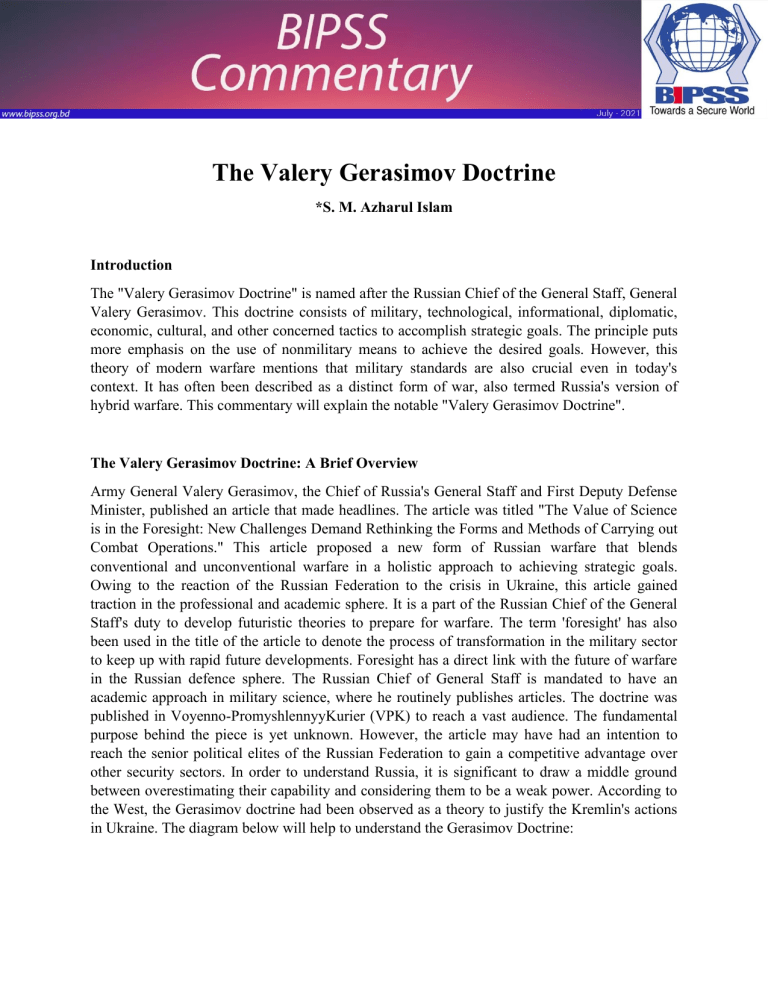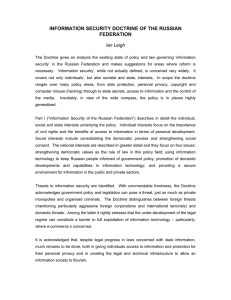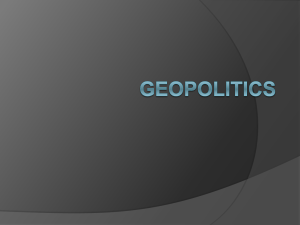
The Valery Gerasimov Doctrine *S. M. Azharul Islam Introduction The "Valery Gerasimov Doctrine" is named after the Russian Chief of the General Staff, General Valery Gerasimov. This doctrine consists of military, technological, informational, diplomatic, economic, cultural, and other concerned tactics to accomplish strategic goals. The principle puts more emphasis on the use of nonmilitary means to achieve the desired goals. However, this theory of modern warfare mentions that military standards are also crucial even in today's context. It has often been described as a distinct form of war, also termed Russia's version of hybrid warfare. This commentary will explain the notable "Valery Gerasimov Doctrine". The Valery Gerasimov Doctrine: A Brief Overview Army General Valery Gerasimov, the Chief of Russia's General Staff and First Deputy Defense Minister, published an article that made headlines. The article was titled "The Value of Science is in the Foresight: New Challenges Demand Rethinking the Forms and Methods of Carrying out Combat Operations." This article proposed a new form of Russian warfare that blends conventional and unconventional warfare in a holistic approach to achieving strategic goals. Owing to the reaction of the Russian Federation to the crisis in Ukraine, this article gained traction in the professional and academic sphere. It is a part of the Russian Chief of the General Staff's duty to develop futuristic theories to prepare for warfare. The term 'foresight' has also been used in the title of the article to denote the process of transformation in the military sector to keep up with rapid future developments. Foresight has a direct link with the future of warfare in the Russian defence sphere. The Russian Chief of General Staff is mandated to have an academic approach in military science, where he routinely publishes articles. The doctrine was published in Voyenno-PromyshlennyyKurier (VPK) to reach a vast audience. The fundamental purpose behind the piece is yet unknown. However, the article may have had an intention to reach the senior political elites of the Russian Federation to gain a competitive advantage over other security sectors. In order to understand Russia, it is significant to draw a middle ground between overestimating their capability and considering them to be a weak power. According to the West, the Gerasimov doctrine had been observed as a theory to justify the Kremlin's actions in Ukraine. The diagram below will help to understand the Gerasimov Doctrine: Figure 1: Adaptive Approach for the Use of Military Force (Source: Military Review) The figure attempts to explain the adaptive approach for the use of military force. First, it establishes the concealed use of military force, which can happen in the following ways: military training of rebels through foreign networks, supply of weapons and resources to the forces which do not support the government, application of special operations forces and private military companies and reinforcement of opposition units with foreign fighters. After that, before proceeding towards the next phase, it is vital to assess whether the resistance of the opposing side has been suppressed. If it has been buried, the next step is to change the political regime. If the opposite side is yet to be suppressed, the next step is to search for the creation of a pretext for conducting a military operation. The illustration below (Figure 2) depicts the "new" approach for achieving political-military goals. This approach is a definite measure to combat the influence of the opposing state involved in the war. It can be done in two ways: adaptive use of force and nonmilitary means. Adaptive use of power includes the following measures: search for a pretext to launch a military operation, implementation of open military interference, application of private military companies, provision of support to armed opposition and special operations forces application. The nonmilitary means are referred to as "color revolutions". "Color revolutions" are used to denote communism related uprisings in the former Soviet Union countries, China and the Balkans. Figure 2: New Approach for Achieving Political-Military Goals (Source: Military Review) Figure 3: Correlation of Nonmilitary and Military Measures (Source: Military Review) The picture above (Figure 3) establishes the link between nonmilitary and military measures. Military measures include military actions of strategic deterrence, strategic deployment, military operations, peacekeeping operations, conduct and information conflict. The nonmilitary measures consist of the formation of the political opposition, actions of the opposition forces, change of the political-military leadership, carrying out strict measures to reduce tensions in relations, a transition of the economy to military lines, economic blockade, economic sanctions, disruption of diplomatic relations, political and diplomatic pressure, the formation of coalition and alliances, and the search for a method of regulating a conflict. Both nonmilitary and military measures have also been categorised into separate layers: the first layer is the covert origin, the second layer is linked with strains, the third layer is initial conflicting actions, the fourth layer is a crisis, the fifth layer is resolution and the sixth layer is the reestablishment of peace (postconflict regulation). Despite putting forward this fascinating theory, the Russian General of the Army wrote about the uniqueness of each war scenario. The author established the distinctiveness of each case scenario during the war and further stressed the aspect of not following a fixed model for all war scenarios. According to the General, each problem should be dealt with per the utilisation of the state's resources and suitability of the operational environment. Figure 4: Use of Military and Nonmilitary Measures (Source: Military Review) The use of military forces has been categorised in traditional forms and methods. The figure above (Figure 4) discusses the forms and ways of using military and nonmilitary measures. This section includes actions such as initiation of military operations after strategic deployment; frontal clash of line-units forces, the basis of which consists of ground troops; the destruction of personnel and weaponry and the consequent possession of lines and areas with the goal of seizure of territories; destruction of the enemy, destruction of the economic potential and control of his territories; the initiative concerned with operations on the ground, in the air and at sea; the command-and-control of forces within a framework of a strictly organised hierarchical structure of command-and-control agencies. Figure 4 also portrays the use of political, diplomatic, economic and other nonmilitary measures in combination with the help of military forces. It lies in the section under the name of new forms and methods. The initiatives concerned with this method are initiations of military operations by groupings of line-units (forces) in peacetime; highly manoeuvrable, noncontact combat operations of inter-branch groups of line-units; reduction of the military-economic potential of the state in a short period; the mass-use of high precision weapons, the use of elite troops, as well as disruptive technological weapons based on new physical principles and the participation of a civil-military component in combat operations; simultaneous effects on line- units and enemy facilities throughout the entire depth of his territories; warfare simultaneously in all physical environments and the information space; the use of asymmetric and indirect operations; and command and control of forces and assets in a unified information space. Conclusion The "Valery Gerasimov Doctrine" is innovative, and it may have a massive impact on the nature of military involvement in the near future. Although this doctrine has received a fair share of criticism, there is no doubt about the sheer intelligence of conceptualising such a masterpiece. The "Valery Gerasimov Doctrine" may help provide critical insight into the significance of both military and nonmilitary means to realise a nation's strategic goals. ……………………………………………………………………………………………………… *S. M. Azharul Islam is currently working as a Research Assistant at the Bangladesh Institute of Peace and Security Studies. Bibliography 1) Bartles, C. K. Getting Gerasimov Right. Military Review. The Professional Journal of the US Army. January-February 2016. Retrieved on 1 July 2021. 2) Boulègue, M.&Polyakova, A. The Evolution of Russian Hybrid Warfare: Executive Summary. The Center for European Policy Analysis. 29 January 2021. Retrieved on 2 July 2021. 3) Mockew, M. K. The Gerasimov Doctrine. Politico Magazine. September/October 2017. Retrieved on 5 July 2021.





